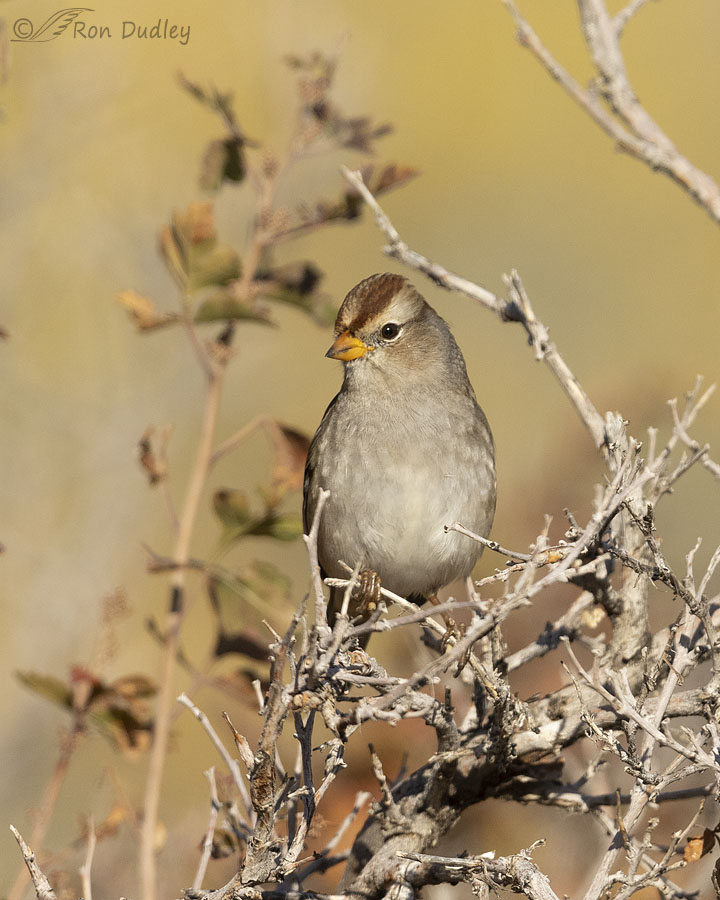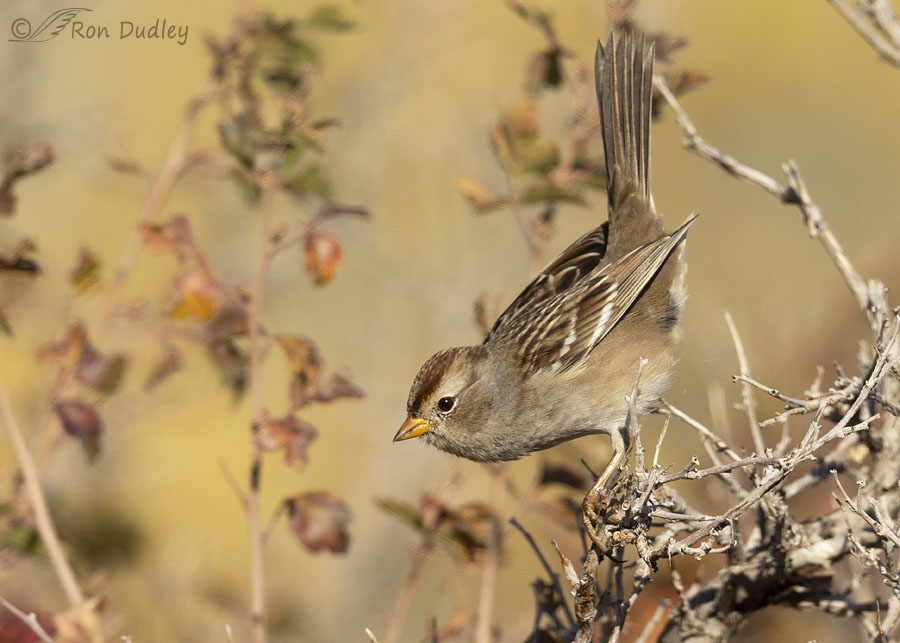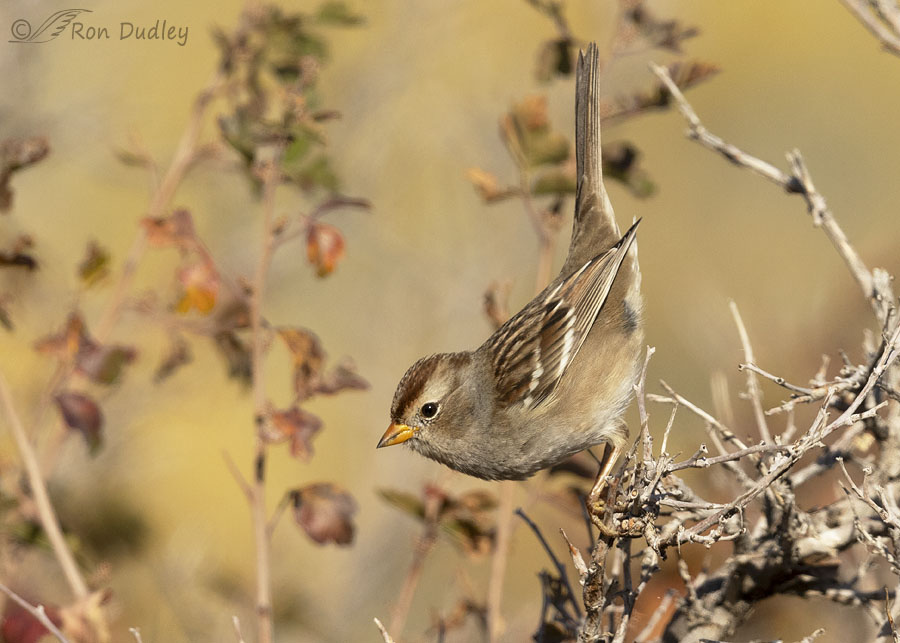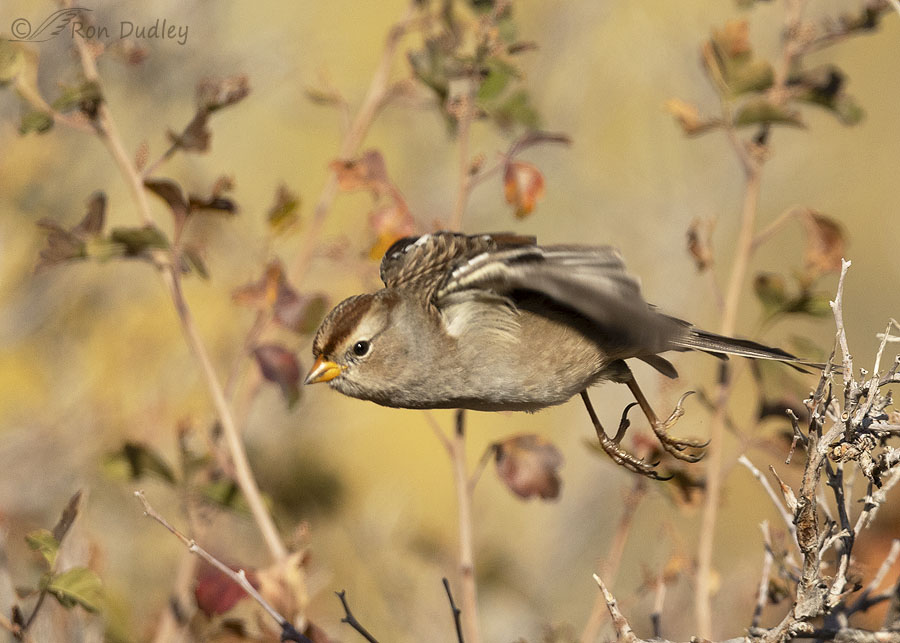Be careful what you wish for.
Seasoned bird photographers know that there are two primary problems (there are others) associated with photographing small birds at takeoff and during initial flight.
- Small birds are almost unbelievably quick and they seldom give any warning of imminent takeoff so when takeoff begins, human reflexes aren’t fast enough to push the shutter button during takeoff. By the time we take that first shot, they’re usually already gone.
- If we’re lucky enough to fire off a shot while the bird is still in frame soon after takeoff, the bird is usually soft. Sometimes it’s because of insufficient shutter speed (motion blur) but more often it’s because the bird didn’t fly in the same plane it was in when it was perched. Super telephoto lenses allow the photographer very little wiggle room with depth of field and even newer mirrorless cameras with amazing autofocus tracking capabilities typically can’t keep up with a small bird in flight.
So let’s see what happened two days ago when I was able to practice takeoff and flight shots when I found a large flock of migrating White-crowned Sparrows in a remote area of northern Utah.

1/5000, f/5.6, ISO 800, Canon R5, Canon EF500mm f/4L IS II USM + 1.4 tc, not baited, set up or called in
When this immature White-crowned Sparrow landed in this spot near the top of a bush I wasn’t pleased with that twig so close to the top of ‘his’ head and I couldn’t see most of his tail. But I had him in frame so I kept him there to see what might happen. With birds you never know.

1/5000, f/5.6, ISO 800, Canon R5, Canon EF500mm f/4L IS II USM + 1.4 tc, not baited, set up or called in
In an instant he moved one step to his right, poked his tail straight up into the air and leaned forward just prior to takeoff. I simply adore this pose and amazingly he held it for long enough (between one and two tenths of a second) for me to…

1/5000, f/5.6, ISO 800, Canon R5, Canon EF500mm f/4L IS II USM + 1.4 tc, not baited, set up or called in
get two shots of it before he took off. I like them both but I prefer the first one because his tail is slightly flared.
This was one of those unusual occasions when a small bird signaled imminent takeoff with its behavior and I was paying close attention so I was able to take advantage of it. For just an instant I remember thinking that I wish I could train ‘my’ birds to signal imminent takeoff in some way. It sure would make getting takeoff and flight shots easier.
But of course, it was only a fleeting and irrational fantasy. If we could train birds to signal imminent takeoff, any fairly competent photographer could get those kinds of shots regularly, so they’d be a dime a dozen. I much prefer things the way they are. The challenge is a big part of the fun of bird photography.
OK, we still have some unfinished business. Did I get a flight shot? And if I did, was it any good?

1/5000, f/5.6, ISO 800, Canon R5, Canon EF500mm f/4L IS II USM + 1.4 tc, not baited, set up or called in
Yes and not really.
I got it but even with some extra sharpening during processing his face, bill and eye are just a little too soft, for the reason I mentioned above. The sparrow took off slightly toward me so by the time this shot was taken he was no longer in the same plane he’d been in while he was perched. He took off in that direction so fast, even the pretty darn incredible autofocus tracking of the Canon R5 couldn’t (or didn’t) quite keep up with him.
Notice that his feet are sharper than his face because his feet are closer to being in the same plane he’d been in while perched. His left wing is much softer than anything else because it’s further out of the original plane than any other part of the bird. With a shutter speed of 1/5000, that wing softness wasn’t caused by motion blur.
Once again, I’ve blathered on far too long about bird photography technique so I’m out of here. Better late than never.
Ron


Glad you blathered on: your comments give context and let me see the photos from a “technical “ perspective.
Catherine
You’re a brave man just for trying
🙂
No pressure, Ron, but I’m happy when I see [New Post] after “Feathered Photography”.
Me too, Marcia. There’ll still be days when I don’t post but hopefully not too many of them.
The small birds often make greased lightening look predictable and slow don’t they?
Even as a happy snapper I appreciate your dilemma – and I am in awe at your accomplishments.
They sure do, EC. And thank you.
Such charming little birds are White-crowned Sparrows — and I’m happy to say they (and Yellow-rumped Warblers) are taking up their winter residence in my yard now! I love these images for their bird life and their colorful background. Though I prefer the second ready-to-launch photo, I think because I see fewer twigs interfering with his/her body parts!
Chris, I keep looking for them but I still haven’t seen my first Yellow-rumped of the year.
Excellent series and you got it. You are so right – almost impossible to get takeoffs with small birds. My camera has a sports action feature that I can use. Just focus on the bird and hit the shutter and hope it takes off. Of course you can waste huge amounts of time doing so as well as battery etc, and in the end even if you get it it is of course not as sharp as yours. I think for take offs I will stick to eagles. 🙂
“I think for take offs I will stick to eagles”
Big birds are sure easier, aren’t they, Everett. Size matters…
What you have captured here is what I long for when watching “my” backyard birds and what the eye can never record, even with the binoculars. So I’ll take all of these as “Perfect” and overlook your worries about softness which is imperceptible to the ordinary observer. (Well, except for the wing in #4. Yes, that is soft, but you explain why so well!) Science class at 7:30am – LOVE it!
“Science class at 7:30am”
Perfect, Carolyn. When I was teaching that’s when my first class always started. Or was it 7:40? I’ve been retired for so long I no longer remember…
Ditto on the marvelous remark.
What I like about #3 is that he or she is farther away from the upright branch by the tail, and there is something about the neatness of the instant that speaks to me of control, not the photographer’s, but the bird’s – so that in #3 I learn something new about the flight logistics of the bird.
Interesting point about #3, Sallie. Thanks.
Personally I consider it “education commentary” rather than “blather”! 🙂 Love that you were able to capture some nice shot of the sparrow even if the flight one is a bit soft!
“Personally I consider it “education commentary” rather than “blather”!”
Good! That was my intention, but intentions don’t always come across as such.
The logistics you have to juggle in your work are mind-boggling !
I love both #2 and #3– and you’re right–the slight flare of tail feathers
in #2 adds a little “something extra”– maybe the extra visual weight
to the rear adds balance to anchor that forward motion. Delightful little critter !
Thank you, Kris. There’s something else I like a little better about #2 over #3. In #2 his left wing is slightly raised from his body, which provides a narrow shadow that defines the wing a little more crisply. It’s a little thing but little things matter…
Blather? I think not. Another tutorial by the professor.
It is a lot of work to take the photos, review and choose the few to publish, edit and process, and them post on the site. You go the extra mile by including narrative, which for me makes it all the richer.
I imagine that in the collective works of FP there is the potential for a book on bird photography.
FWIW I think all the above photos are marvelous.
I appreciate your encouragement immensely, Michael. Thank you.